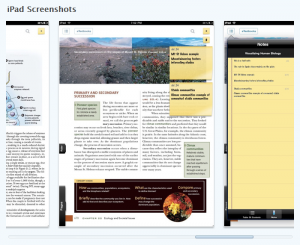Weber Media Partners | Impressions Through Media
Conversational Marketing in the Age of Social Media
- Home
- About This Blog
- Contact
- Sitemap
Archive for the ‘facebook’ Category
The Real Cost of Social Media Info Graphic
Author: Catherine Weber15 Aug
At Weber Media Partners, we love info graphics. This one is so interesting we are going to post it even thought it is enormous. Thank you to Focus.com for putting this together.
- 0 Comments
- Filed under: business, facebook, social media marketing, twitter, youtube
How Social Media Enabled Egypt’s Revolution: Part Three
Author: Theresa Grenier26 Jul
 In the last of our three-part series on the role of social media in Egypt’s ongoing revolution, we speak directly with Amr Abouelleil, who is one of the growing number of international Egyptian Youth Movement members.
In the last of our three-part series on the role of social media in Egypt’s ongoing revolution, we speak directly with Amr Abouelleil, who is one of the growing number of international Egyptian Youth Movement members.
Abouelleil is a 36 year-old Egyptian-American writer and bioinformatics analyst living in Massachusetts with his family. He lived his early life in Egypt, and returns every year to visit family, including a female cousin who is active in the revolution. His most recent trip was this past April, where he witnessed the effects of Egypt’s revolutionary activity first-hand.
His take: social media has been the cornerstone of communications during the revolution. Without social media, access to factual information would be limited, and more than likely colored by government spin and propaganda. It has enabled international supporters like Abouelleil to connect first-hand with other Egyptians, and to reach out to a broader audience to both gain support for the revolution and address the misinformation that abounds in traditional media and on the internet.
We hope you find yourself as inspired as we have been by the power of social media, and the strength and passion of those using it to build a better future for their country.
- 0 Comments
- Filed under: blogging, egypt, facebook, social influence, social media marketing, social media revolution, twitter, viral video, youtube
How Social Media Enabled Egypt’s Revolution: Part Two
Author: Theresa Grenier1 Jul
Two Can Play at this Game: World Governments’ Responses to Social Media as a Revolutionary Tool
 In the first part of this series, we explored how social media enabled and facilitated Egypt and Tunisia’s revolutions. By using Facebook and Twitter to broadcast their beliefs, find like-minded individuals the world over, and organize protests in near real-time, the revolutionaries were able to stay one step ahead of their governments. But now, it seems, the governments are catching up.
In the first part of this series, we explored how social media enabled and facilitated Egypt and Tunisia’s revolutions. By using Facebook and Twitter to broadcast their beliefs, find like-minded individuals the world over, and organize protests in near real-time, the revolutionaries were able to stay one step ahead of their governments. But now, it seems, the governments are catching up.
In Egypt, segments of the government and army are now on Facebook, using it as a means to spread their own propaganda and to keep an eye on known activist communities. At one point during the revolution, the Egyptian government even shut down internet access, fully aware of the threat it posed to the government. Amr Abouelleil, an Egyptian-American bioinformatics analyst and writer who is actively involved with the Egyptian Youth Movement at the heart of the revolution, says the government was aware that without the internet, people would have to turn to state television (which is government-censored) for their news. The government used this opportunity to up their ante, broadcasting pro-government programming to the unwired masses, which in many cases, appeared to work. “The government got some people to change their tune in just a matter of days,” Abouelleil says. “It brainwashed them to go back on Facebook in the government’s favor instead.”
Egypt is not the only government in fear of the power social media and the internet provides its people; when Google reportedly foiled an alleged Chinese attempt at stealing the passwords to hundreds of Google accounts, including those of government officials, Chinese human rights activists, and journalists. The Chinese government has since denied involvement, but is well known for their censorship of the internet and television. Whether or not the government is responsible for the hacking attempt, it’s safe to say that they are well aware of the power of the internet and social media, and doing all they can to control it.
Government reactions to the use of Google and social media have been so extreme in recent months that Google Executive Chairman Eric Schmidt has said he fears for the safety of Google employees in certain parts of the world. “There are countries where it is illegal to do things that Google encourages. In those countries, there is a real possibility of (employees) being put in prison for reasons which are not their fault,” Schmidt told attendees of Google’s Dublin summit on militant violence this past Monday, June 27.
A prime example of this is Wael Ghonim, the Egyptian Google executive who is now one of TIME magazine’s 100 most influential people of 2011. Ghonim was held captive by the Egyptian government for eleven days in early 2011 due to his involvement in using Facebook to organize protests via a page called “,” which exposed and raised awareness of the military’s cruel and inhumane murder of Khaled Saeed.
How Social Media Enabled Egypt’s Revolution: Part One
Author: Theresa Grenier22 Jun
 For hundreds of years now, the printed word has given a voice to the people. It has enabled repressed religious groups to establish their freedom and independence, and allowed fledgling countries to organize the support and manpower needed to break free from their oppressive overlords. There are centuries of evidence that the pen is, indeed, “mightier than the sword;” but in our age of technology, it appears that the Tweet may be mightier than the pen.
For hundreds of years now, the printed word has given a voice to the people. It has enabled repressed religious groups to establish their freedom and independence, and allowed fledgling countries to organize the support and manpower needed to break free from their oppressive overlords. There are centuries of evidence that the pen is, indeed, “mightier than the sword;” but in our age of technology, it appears that the Tweet may be mightier than the pen.
We all know by now about the recent social-media fueled upheavals in Egypt and Tunisia; protestors took to the web to voice their views and organize protests, acts which ultimately led to a successful revolution. Social media has given people a larger, louder voice than ever before. It allows them to reach the like-minded in both their own country and across the world. And perhaps more importantly, they are able to do it INSTANTLY. Revolutions that would have taken 10, 20, 30 years in the days before social media can now occur in that many months. Protests that would have taken weeks or months to organize can now happen in hours.
Let’s take a look at historical past revolutions. The Protestant Reformation, for example, would never have been made possible without the invention of the printing press. Johannes Gutenberg’s invention allowed Reformation leader Martin Luther to write and publish his beliefs prolifically, without Church censorship, and to distribute them to his followers and like-minded individuals, thus thrusting the reformation to the forefront of the public consciousness. Within 6 years, half of the printed works in Germany were written by Luther.
Then there is the American Revolution. Without Benjamin Franklin’s postal service, would missives have had such wide-spread reach? An organized means of distributing written information was essential to the fledgling colonies breaking free of British rule, and again in establishing the United States as a nation.
So we can see that the printed word has long played a role in disseminating information about dissidence and revolution to the people of the world and inciting the public to action. The difference between then and now is that now the people have the ability to instantly act on that information and reach a global audience.
It is important to note that, contrary to what the media and some extreme social media advocates are saying, the recent uprisings were not, in fact, “caused” by social media. They were caused by political unrest, government and military abuses of power, and poor treatment of a country’s citizens, and those citizens being unwilling to stand for it. The revolutions were, however, enabled and facilitated by social media, and quite possibly might not have been successful without it.
Stay tuned in the upcoming weeks as we post parts two and three in this series, where we’ll explore the government’s reaction to social media’s involvement in the Egyptian revolution, and speak with an Egyptian-American who has been active in using social media to advance the revolution from his home in the United States. And as always, we welcome your opinions and comments on this post and the topics it covers!
*UPDATE*
Part 2 is now up. Two Can Play at this Game: World Governments’ Responses to Social Media as a Revolutionary Tool
Image: Gigi Ibrahim via Flickr
- 1 Comment
- Filed under: facebook, social influence, social media marketing, twitter, viral video, youtube
Facebook in 2011 – What’s New This Year?
Author: Jaclyn Mosher12 May
2011 is nearing its halfway point, and we’ve already seen some dramatic changes in the social media world. The tablet war is heating up, social shopping has become big business, and just this week, Microsoft announced the purchase of Skype for a whopping $8.5 billion. 2011 has also been a big year for Facebook, with its still-growing user base and the increasing promience of “find us on Facebook” messaging in ads from everything from Nissan cars to Energizer batteries to Macy’s Deparment stores to Fancy Feast cat food.
Facebook has also made several key changes to its site in the first half of 2011. We detail these changes below, discuss what these changes mean for Facebook and it users, and look forward to changes that are reportedly in the works for the rest of 2011.
Instant Comments
 In 2011, Facebook made it even easier for friends and fans to share their comments. In March, Facebook removed the “comment” button, previously the last step in the commenting process. Instead of a button, users simply need to press ”enter,” and the post appears in the news feed.
In 2011, Facebook made it even easier for friends and fans to share their comments. In March, Facebook removed the “comment” button, previously the last step in the commenting process. Instead of a button, users simply need to press ”enter,” and the post appears in the news feed.
This change is more than just about ease-of-use, however. This faster submit process is a signal of the primacy of data in the Facebook ecosystem.
Facebook’s astronomically high value (currently projected at $50 billion) is largely due to its ability to foster countless, continuous conversations among its over half a billion members. Every company wants to the know what the world thinks of its new product – Facebook is the closest we’ve come to developing a way to do just that.
By making comments that much easier to submit, Facebook is in effect generating more and more data to add to its arensal. The comment button provided users with a prompt to review their content before submitting it. By replacing it with a keystroke, Facebook has in effect moved sharing into the composition process. A click requires a shift in focus from the keys to the cursor. ”Enter” is just another keystroke. Only this keystroke just happens to publish your thoughts to the world.
How can all of this derive from just one missing button? When you are dealing with a worldwide network the size of Facebook, one change can impact how the world shares information.
Best Back To School Campaigns, Part III: Bookstore Alternatives
Author: Jaclyn Mosher1 Sep
Part III of our Best of Back to School marketing campaigns of 2010 dives into the changing world of college textbooks. In recent years, numerous companies have sprung up offering alternatives to the notoriously expensive college bookstore. This year, I was particularly impressive by two such companies – Coursesmart and Chegg.
Through its sleek, easy-to-use website, Coursesmart offers an ever-growing selection of “e-textbooks” – electronic versions of the traditional print texts that can be read on desktops, laptops, iPads and even iPhones. Coursesmart’s e-textbooks give the reader the ability to highlight sections, take notes in the margins, print selected pages and cut and paste selections. Now there is no need to carry around tons of heavy books – you can keep them all on our laptop, read for easy access with just one click.
 I was particularly impressed by Coursesmart’s synergy with Apple products. Being able to access textbooks from an iPhone is the ultimate in transportable texts. Furthermore, the iPad opens the door to more interactive and impactful textbooks. (See image above for an example of a Coursesmart text viewed on a iPad.) The Wall Street Journal discussed the iPad and Coursesmart’s innovative e-texts in a recent article, stating that the new device makes book publishers “eager to exploit its color, video, and touch-screen capabilities.” I, for one, would love to test drive this exciting new technology.
I was particularly impressed by Coursesmart’s synergy with Apple products. Being able to access textbooks from an iPhone is the ultimate in transportable texts. Furthermore, the iPad opens the door to more interactive and impactful textbooks. (See image above for an example of a Coursesmart text viewed on a iPad.) The Wall Street Journal discussed the iPad and Coursesmart’s innovative e-texts in a recent article, stating that the new device makes book publishers “eager to exploit its color, video, and touch-screen capabilities.” I, for one, would love to test drive this exciting new technology.
Of course, this new technology comes with a big price tag. Coursesmart’s e-textbooks, while less expensive than print versions, can still run in the $100 range. And then there’s the iPad, priced at $499 – a very pricey item to pile on top of an already expensive back to school season. Another textbook innovator, Chegg, combines new and old technology to offer a more affordable alternative.
(more…)
- 0 Comments
- Filed under: books, e-texts, facebook, social media marketing
Best Back To School Campaigns, Part II: Target’s Social Checklist
Author: Jaclyn Mosher27 Aug
On Wednesday, I kicked off my series on the best Back to School marketing campaigns of 2010. I sought out campaigns that are innovative, fun and helpful, both to the shopper and the community at large. In Part II of the series, I will highlight Target’s innovative and extremely useful “Roomates” Facebook app.
Target is a popular destination for college students stocking up on dorm necessities. To help ensure these coeds get everything they need, Target has developed . The checklist has three options (“buy,” “have” and “pass”), and includes links to purchase specific products on Target.com.
The best part about this campaign, however, is the roommates option. This part of the app allows students to share their list with their roommate(s), helping ensure that one suite will not wind up with four vacuums and only one lamp. The app also features messaging, calendars, and even a bill splitter – definitely something I wish I had in college.
Once the checklist is complete, students can select the print option and bring the list along on their shopping trip. The checklist is even available on Target.com in a more traditional PDF format. All in all, this campaign is a helpful tool for college students, as well as an ingenious way to show off the megastore’s seemingly innumerable product offerings.
Stop by our blog on Monday for the conclusion of this series, in which I discuss two innovative and cost-effective alternatives to the traditional college bookstore.
- 0 Comments
- Filed under: facebook, social media marketing
Best Back To School Campaigns, Part I: Staples Makes a Difference
Author: Jaclyn Mosher25 Aug
Two weeks ago, a milestone was reached: I received my first school-related e-mail message. It opened with a jolly greeting from my professor, and moved quickly to talk of future assignments and course requirements. That’s when it hit me – I need to get ready for back to school!
As a grad student, I’ve done the Back to School ritual more times then I’d care to count. So, to liven up the hunt this year, I’ve added an additional item to my usual list of notebooks, highlighters and (of course) new shoes – find my favorite Back to School marketing campaigns. I sought out campaigns that are innovative, fun and helpful, both to the shopper and the community at large. A lucky few made it to the top of the class, and I will detail those campaigns in a series of three posts. Today, I will profile Staples’ philanthropy.
 Students and parents browsing the aisles (or web site pages) of this office superstore for back to school necessities can do more than just buy – they can give back, too. For the third year in a row, Staples has partnered with teen-centric non-profit DoSomething.org to collect school supplies for children in need. Donation bins have been set up in Staples retail locations across the country, and school supplies of all kinds will be collected now through September 18th.
Students and parents browsing the aisles (or web site pages) of this office superstore for back to school necessities can do more than just buy – they can give back, too. For the third year in a row, Staples has partnered with teen-centric non-profit DoSomething.org to collect school supplies for children in need. Donation bins have been set up in Staples retail locations across the country, and school supplies of all kinds will be collected now through September 18th.
This year, Staples used and a celeb-filled online game to help students get involved. Teen can vote to join their favorite celebrity’s “pack,” and in the process donate $1 to the cause. Donations are also accepted via text message.
All in all, I loved Staples’ idea and its execution. These simple donations are a great way to teach everyone from preschoolers to high schoolers the importance of generosity and kindness towards those who are less fortunate. Furthermore, through their Do Something 101 microsite, they provide helpful tips that help students run their own school supply drives – the lesson being that teens can really “do something” big to help their communities.
Judging by the 28,000 Facebook fans and thousands of votes on the contest page, this event is a proving to be a success. Even Staples’ archrival Dunder Mifflin is getting in on the action! With that endorsement secured, I now know where I’ll be purchasing my paper…
I hope you have enjoyed this first installment of my survey of the best of Back to School. Be sure to visit our blog soon to see who else made the list!
- 1 Comment
- Filed under: facebook, social media marketing, web 2.0
Nonprofits Need to Develop a Social Media Strategy
Author: Catherine Weber16 Jul
 Earlier this week I spoke on a panel of social media professionals to 70 executive directors and marketing staff of nonprofit organizations at Simmons College in Boston. The subject was Social Media: Tips and tools for using social media to build support for your mission. The event was organized by the Center for Non-profit Success.
Earlier this week I spoke on a panel of social media professionals to 70 executive directors and marketing staff of nonprofit organizations at Simmons College in Boston. The subject was Social Media: Tips and tools for using social media to build support for your mission. The event was organized by the Center for Non-profit Success.
We had a great group of panelists who provided a balance of tools, case studies and strategy. My task was to present on strategy. While everyone had a Facebook presence, only two or three audience members had a strategy to back up their social media activities. This is common amongst most nonprofits and many for-profits. Unfortunately, without a strategy in place, these organizations may not be creating content that serves their audience, delivers on their organizational objectives or have the triggers in place to understand how successful their programs are.
(more…)
- 1 Comment
- Filed under: facebook, nonprofit, social media marketing, social media marketing
Social Media Leaders and Laggards: Healthcare, Retail Sprint Past Financial Services, Energy
Author: Jaclyn Mosher14 Jul
It may be early on in the race to Social Media marketing success, but there are already some notable leaders and laggards emerging. Which industries are the ambling tortoises, and which are the speedy hares?
In this post, we will review the findings of a recent report from intelligence provider Social Media Influence (SMI), and share our own analysis to help you handicap this race to success.
In their June report entitled “The State of Social Media Jobs 2010,” SMI surveyed the marketing departments of all Fortune 100 companies, to find out whether they have in-house social media resources, outsource their social media campaigns, or have little to no investment in social media marketing.
The graph below shows the results of their survey. The blue line represents the total number of companies in that industry, while the red line represents those companies in that industry that SMI deems “social media-savvy” (i.e. they devote significant in-house resources to social media marketing efforts). As you can see, the leaders of the group include Tech/Consumer Electronics, Healthcare, Retail and Automotive. On the flip side, the laggards are Petroleum/Energy, Financial Services/Insurance and Utilities. (Click to enlarge image.)

(more…)
- 3 Comments
- Filed under: facebook, social media marketing
- Subscribe To Feed (RSS)
- Comments (RSS)
- Subscribe via Email






Recent Comments
Do businesses need both?